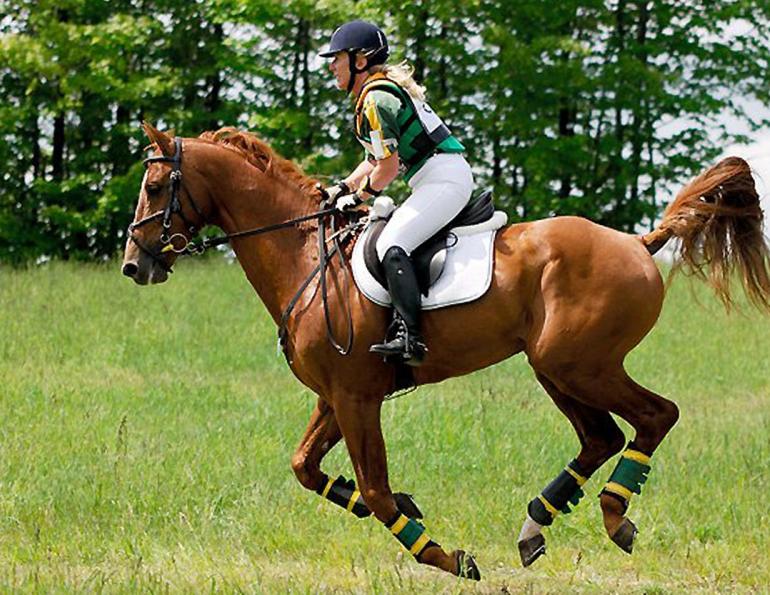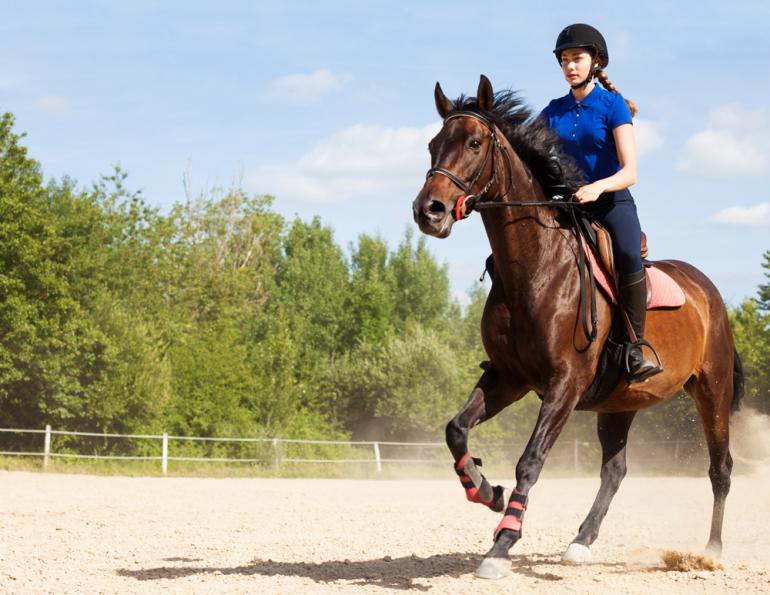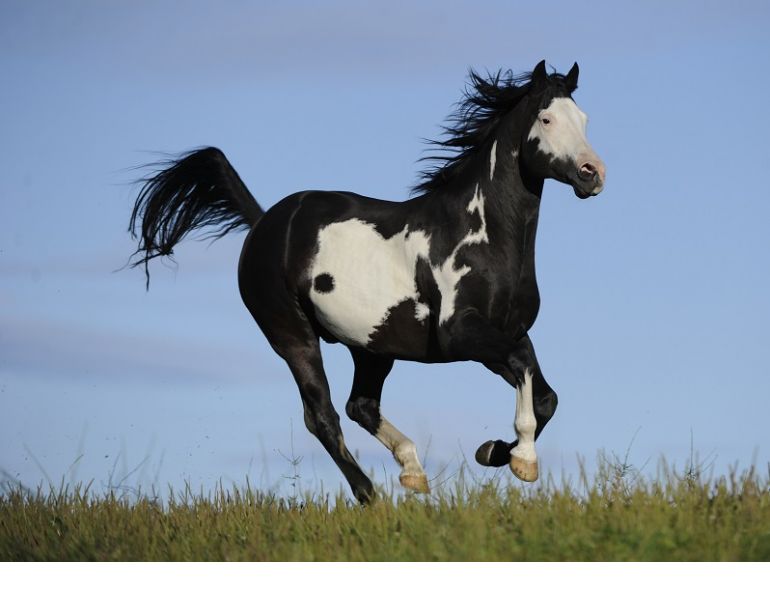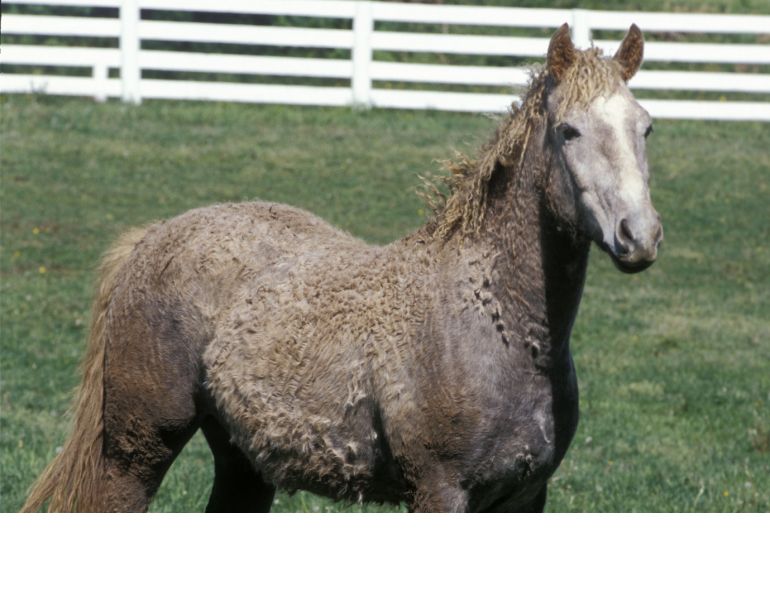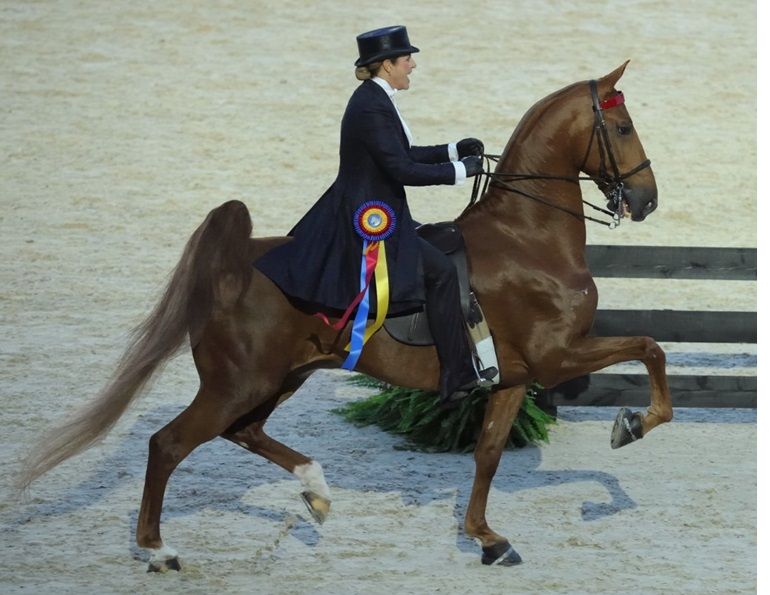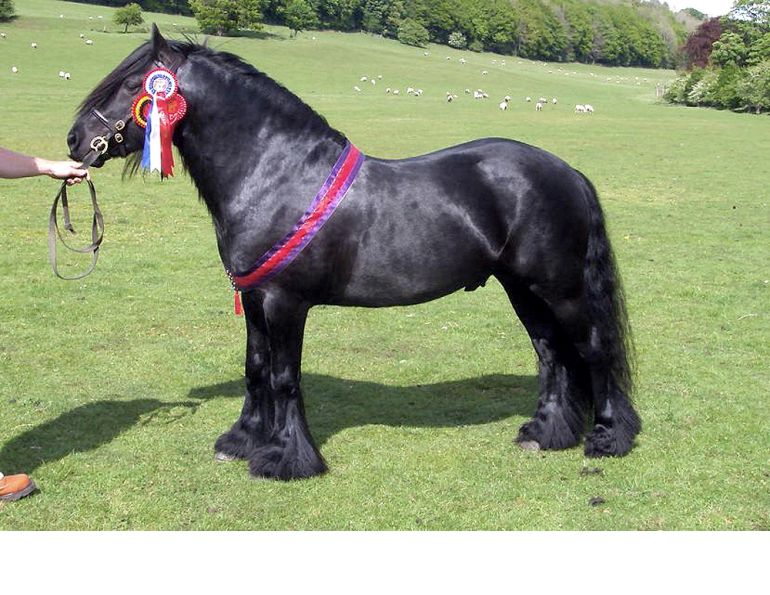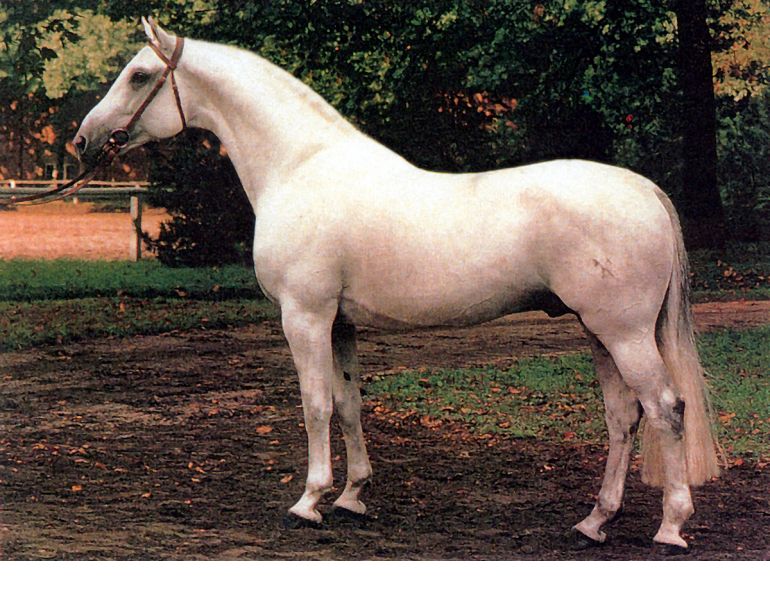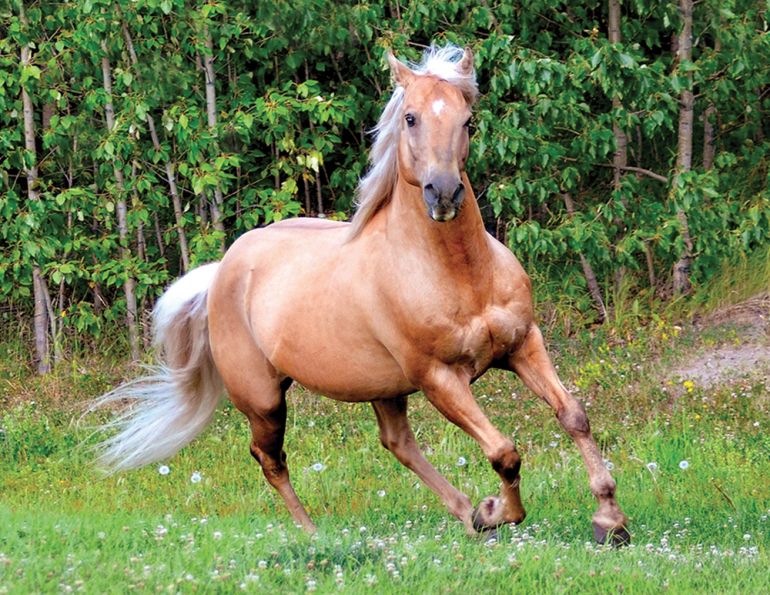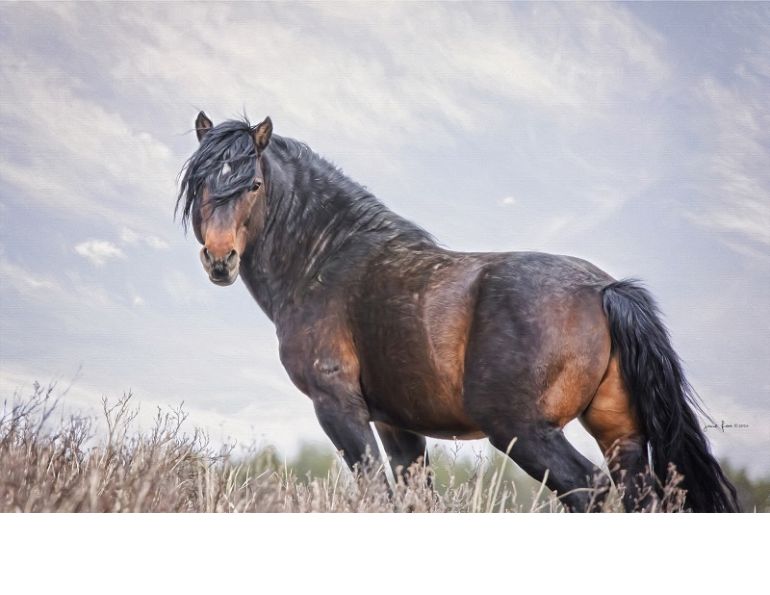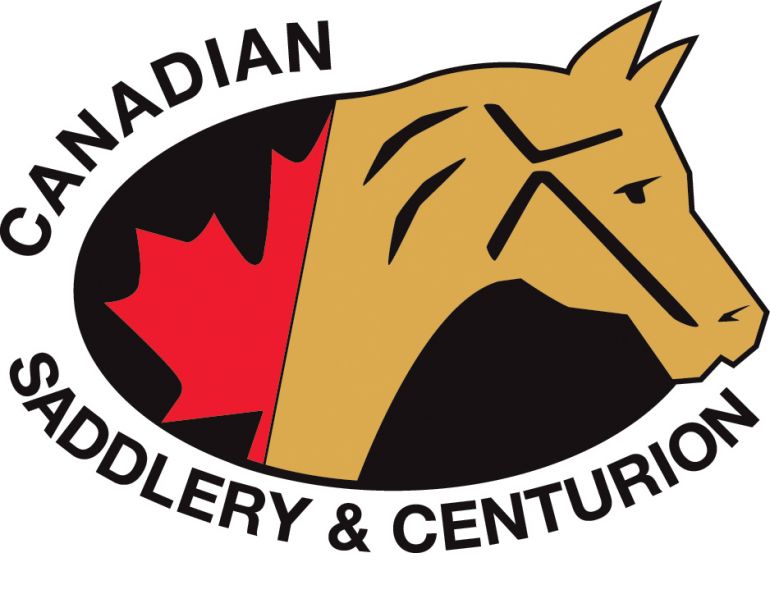By Jess Hallas-Kilcoyne
In the last article, "The Charismatic Canadian Warmblood, Part 1," we looked at both the historical background and modern state of the Warmblood breed and foundation stallions for the Canadian Warmblood Horse Breeders Association (CWHBA), as well as the founding of the CWHBA. In this article, we’ll explore the registration, licensing, and inspection procedures of the Canadian Warmblood, the present state of Warmblood breeding programs in Canada, the future of the CWHBA, and the Canadian Warmblood in sport today.
To fully understand the future of the Canadian Warmblood, let’s take a closer look at the CWHBA registration and approval processes.
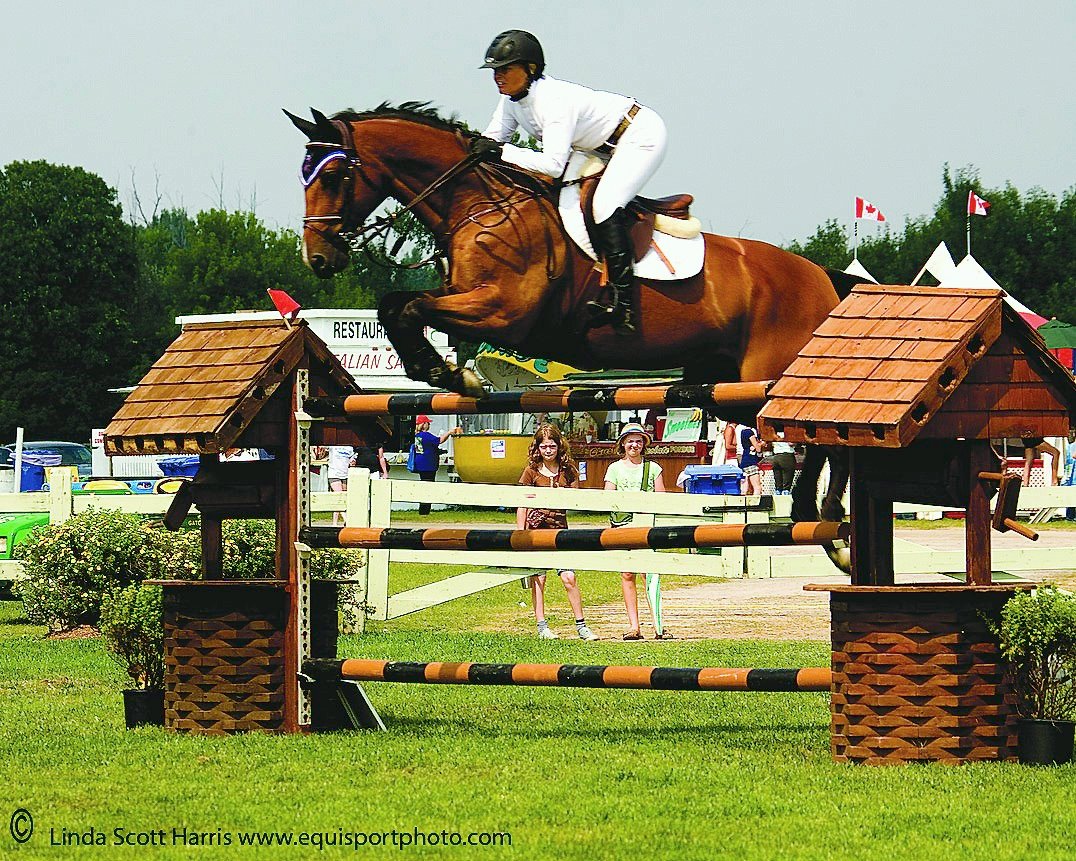
Simply Ahorn, now competing as Belmont, is pictured here during the early days of his show jumping career with Erynn Ballard. The gelding, by Ahorn out of a Landfriese II mare, competed for a time with Olympian Nick Skelton of Great Britain, and is now ridden by Laura Kraut of the US for owner Mrs. B. Widdowson. Simply Ahorn was bred by Canterbrooke Farms in Ontario. Photo: Linda Scott Harris, www.equisportphoto.com; Courtesy of CWHBA
Registration
Whatever the breed association, registration certificates are essentially birth certificates, explains Chris Gould, Chairman of the CWHBA. If you are issued a Canadian birth certificate, you may apply for citizenship in another country, but you will always retain your original birth certificate.
Similarly, a registered Hanoverian stallion from Germany may be entered in a Dutch stud book, but that stallion will always remain registered with the Hanoverian association.
The CWHBA registration process is modelled after the European Warmblood registration system, which allows all foals born to parents entered in the stud book to receive a registration certificate. Registration certificates include such information as pedigree, breeder, owner, and the horse’s physical description.
Registered Canadian Warmblood horses are then eligible to participate in CWHBA inspections.
Mare and Stallion Inspections
Mare and stallion inspections were developed as a means of giving breeders the tools to improve the quality of the horses they are producing. In order to do this, it is crucial that emphasis be placed on breeding the best possible mare to a stallion which complements her positive attributes, and has the potential to overcome her weaknesses.
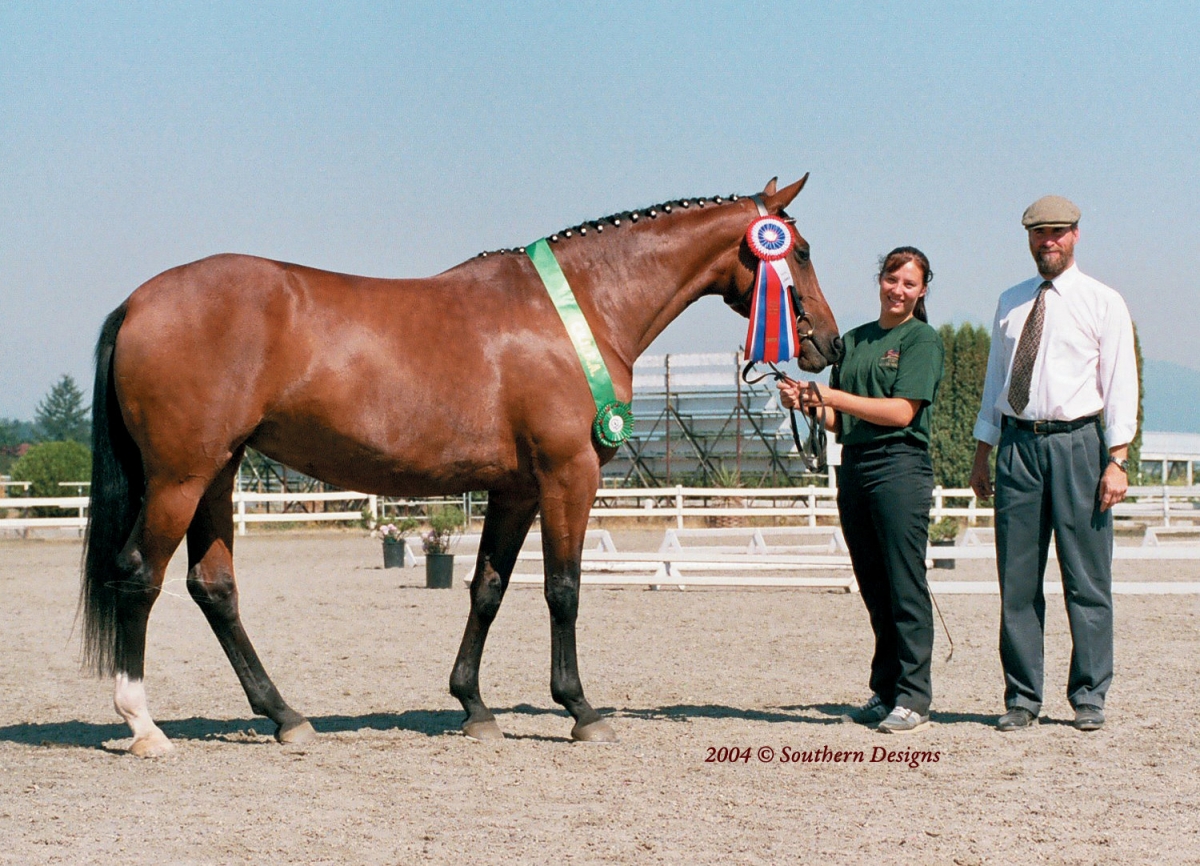
I.H. Tesar, a 1999 mare by Footloose out of a Charles Le Temperaire mare, and bred by Brian and Joan Bourke of BC, went premium at her inspection. The mare’s stance is an excellent example of a correctly “stood up” horse at an inspection. Photo: Southern Designs; Courtesy of CWHBA
Mares must be at least three years old at the time of inspection and stallions at least two and a half years old. Mares and stallions are both inspected in hand on the triangle which allows the judges to examine the horse’s conformation and movement.
First, the handler allows the judges to inspect the standing horse from the front, side, and back of the horse. Next, the handler walks the horse straight away and towards the judges. Finally, the handler trots a triangular course, demonstrating both working trot and extended trot in hand. The triangle allows the judges to evaluate the horse’s trot from behind, the side, and the front.
Finally, horses are presented together in a group walking on a large circle. Stallions also perform at the canter and in the jumping chute while loose in the arena.
Both mares and stallions are evaluated on the following six criteria:
- breed and sex type;
- quality of conformation (focusing on head, neck, saddle position, frame, forelegs, and hind legs);
- correctness of gaits;
- swing and elasticity of gaits;
- walk, and
- general impression and development.
In addition to these six categories, stallions are also judged on:
- the gallop, and
- jumping ability based on an average of separate scores for scope and technique.
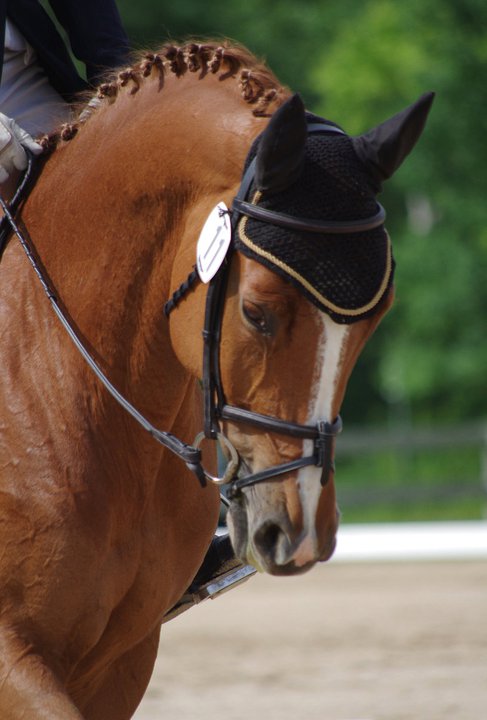
Unbelievable (aka “Nelly”) is by Oxford out of Artemis and was bred by Sheryl Feller of Bluebear Farms in Manitoba. Her refined head and expressive face are typical of the Canadian Warmblood. Photo: Barb Wansbutter
Each category is judged and awarded a score out of 10. The final score awarded to each horse is determined on the average of the scores in the six categories for mares, and the eight categories for stallions.
At the end of the inspection, depending on their final score, a mare may be approved for entry in one of the mare books in the CWHBA stud book.
Stallions that successfully pass their inspection with a final score of at least seven, and no score lower than five in any of the eight categories, will be licensed for breeding for two years.
All stallions and mares presented for evaluation at an accepted Warmblood Keuring (inspection) must supply mane hair for a DNA profile.
Although the current inspection process has proven invaluable in the development and improvement of the Canadian Warmblood, there is still no specific category for evaluating the temperament of the horses being inspected.
“We’re in the process of trying to re-evaluate our inspection process to come up with better ways of evaluating disposition,” says Jennette Coote, a breeder of Canadian Warmbloods from Olds, Alberta, Stud Book Committee Member, and one of the National Directors for the CWHBA. “Down the road, that will be part of the evaluation process...we just haven’t figured out how. How do you test for that in an efficient manner?”
“The Dutch have looked at a number of tests to determine a young horse’s disposition,” Coote continues. “For example, they ask a horse to cross a bridge and take note of the horse’s reaction and how long it takes him to come across it. They dropped an umbrella from the roof of the arena and then looked at how the horse reacted, seeing how long and far away he ran.”
Stallion Approval
The CWHBA approval process consists of two steps: a licensing inspection and a performance evaluation.
If a stallion passes the inspection and receives a two year breeding license, he must them successfully complete the performance requirements within those two years, otherwise that license will expire. Upon passing both the licensing and performance requirements, the stallion will be fully approved in the CWHBA stud book.
Stallion Performance Requirements
There are two main ways in which a stallion can meet his performance requirements. The first is participation in a CWHBA recognized Stallion Performance Test (SPT) with a final indexed score of at least 70. SPT’s are intended as a means by which to evaluate a stallion’s potential as a sire.
SPT’s run by other organizations, the results of which are accepted by the CWHBA, fall into two categories, short tests (ten days or less) and long tests (30, 70 or 100 days). During the long test, the stallion undergoes a training program at an approved facility. This training program includes work in dressage, jumping, and in some cases, cross country. At the end of the training period, the stallions complete a riding horse test in which they are judged on their aptitude for these disciplines.
The CWHBA runs an annual short test modeled after the Swedish SPT. The short test evaluates the same criteria as the longer formats, but differs from the others in that it is the stallion owner’s responsibility to train and present their stallion to the judges. As in the longer tests, the stallions are evaluated by a panel of international judges and independent test riders.
The first CWHBA SPT took place on September 5, 2000 in Olds, Alberta. Fourteen stallions, both Canadian bred and imported, ranging in age from three to thirteen, were shown in front of an international panel of judges. Registered Canadian Warmbloods acquitted themselves well, taking four out of the top six places, including Champion and Reserve Champion.
The second common mechanism for getting performance stallions into the Stud Book approval is the demonstration of performance capability by:
- Placing five times in the top three in Intermediaire dressage competition; or
- Placing five times in the top three in National Open Jumper competition; or
- Placing three times in the top ten in CCI** competition; or
- Winning three Open Hunter Championships at Class 1 shows.
If a stallion is unable to complete the performance requirements, due to injury or age, he may still be entered in the CWHBA stud book if evaluation of the conformation, and/or competition performance of at least 15 of his offspring, deem him suitable.
Apart from CWHBA registered, licensed, and tested stallions, and those for which special provision is made, other stallions eligible for Stud Book approval include:
- All tested stallions of recognized Warmblood breeding; and
- A limited number of stallions having desirable pedigree or performance, i.e. racing Thoroughbreds.
The Stud Book
The Stud Book is the means by which the quality of Canadian Warmbloods is preserved. All mares and stallions must be entered in the Stud Book before they are used for breeding.
There are seven sections in the Stud Book:
- General Stud Book (G)
- Stallion Book (S)
- Main Mare Book (MM)
- Mare Book (M)
- Pre-Mare Book I (P1)
- Pre-Mare Book II (P2)
- Auxiliary Book (A)
EEF Sampson is a 2008 registered Canadian Warmblood by Sambuca out of an Elito mare. He was bred by Cassandra Wunsch of Elegant Expressions Farm and sold to Alexis of New York, with whom he won High Point Champion JR/YR at his first competition. Photo: Jenn Pratt
Registration certificates for horses by entered and approved stallions out of entered mares are provided by the General Stud Book. The other five sections of the Stud Book accept horses only once certain conditions have been met.
Some conditions are shared among books. For example, all the mare books, with the exception of the Auxillary (A) book, require a mare to be sired by a stallion which is entered either in the CWHBA stud book or that of a recognized Warmblood registry.
Other conditions are specific to a single book. The Pre-Mare Book II (P2) is the only book in which Thoroughbred, Arabian, and Anglo-Arabian mares may be entered, provided that they are awarded at least four points in each of the six categories that make up the mare inspection, and an overall score of at least six. These distinctions between books keep bloodlines true and keep the standards of Canadian Warmblood breeding on equal footing with Warmblood breeding programs in Europe.
The Canadian Warmblood Today
Warmblood breeding has truly taken off in Canada in the last 20 years since the founding of the CWHBA.
“All our offspring are registered with the CWHBA,” says Bonny Bunda, who runs Grand Prix Breeders Equestrian Centre in Kars, Ontario. “I believe it’s a quality organization and they are based on bloodlines...one of the ancestors must be from a European stallion.”
WKM Sterling, bred by WKM Stables, is a Nickelson B x WKM Jade gelding currently competing and winning in the 1.0 metre and 1.10 metre show jumping divisions. At the Royal Manitoba Winter Fair in March 2010 Sterling was named Reserve Champion in the 4-year-old Young Horse Development Division. Photo: Wilf McKay
Bunda’s breeding goal is to produce quality show horses with European bloodlines which are suitable for competition in upper-level jumping and dressage. “A good product is all we want to produce,” she says. “It’s always upgrading, and in turn the association is upgrading. I think the Canadian Warmblood has a wonderful future!”
Donna Hagan, of M3 Warmbloods, agrees. Over the years, she and partner Don McPhee have bred and raised many Warmbloods that have gone on to successful show careers. “We have so many great quality stallions in Canada and our breeding philosophy is to breed the best mares to the best possible stallions,” says Hagan. “All our mares are premium mares and we’ll just continue with the policy to pick the best stallion for that mare.”
One of Hagan’s 2006 offspring, Alena, by Lemoto and out of a Pik Bube mare, was the highest scoring Canadian Warmblood mare in Alberta in 2009, with a score of 8.5 at the northern show. She went on to claim the FEI 5-year-old Reserve Championship for Alberta in 2011. Hagan describes Alena’s filly, Aldena, by the popular Hanoverian stallion Dancier, as “representative of our continued breeding objectives,” says Hagan.
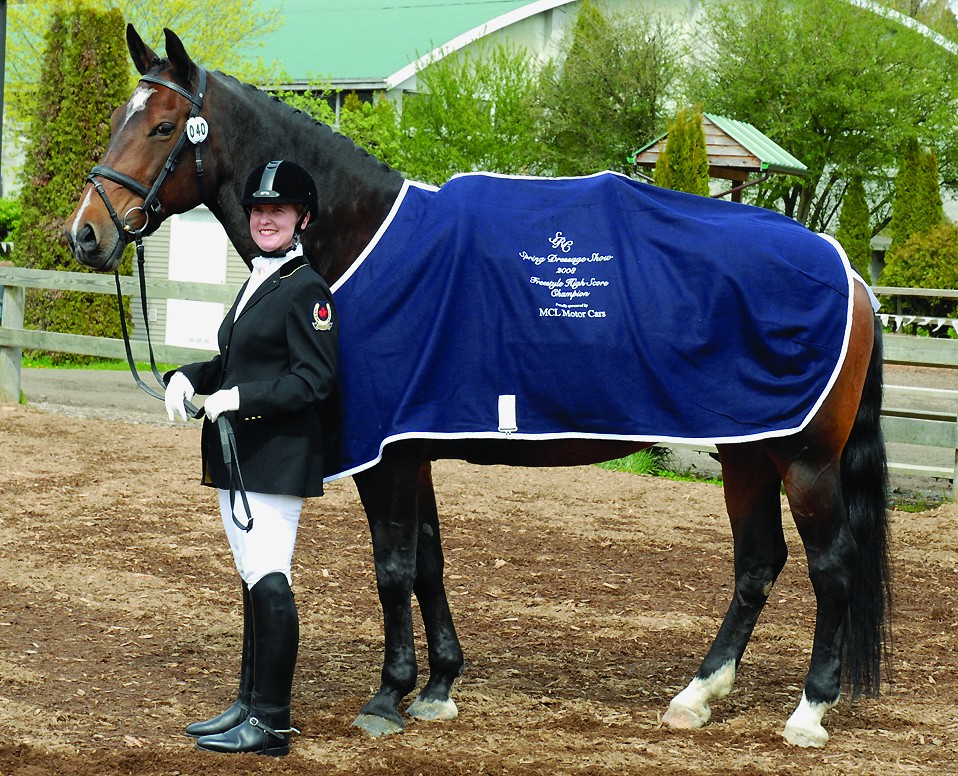
Valentine II, a Vulcaan/Tiki Tez mare, competed on the Canadian Para-Equestrian team at the 2008 Beijing Olympics with Jennifer McKenzie of BC. Valentine II was bred by Heather Heier of BC. Photo: Steve Charles, Totem Photographics
M3 Warmbloods is also responsible for breeding Go for the Gold (aka Goldie), by Gervantus out of a Donner Bube mare, who was the four-year-old champion and FEI High Point Young Horse in Alberta in 2010. The same year, Goldie sold at the CWHBA’s Fall Classic Breeders’ Sale to trainer and Equine Canada Level 3 coach, Simone Williams of Queenswood Stables in Ottawa, Ontario.
Williams describes Goldie as “a wonderful, talented mare. She is the perfect combination of sensitivity and relaxation...she impressed me the first time I rode her with her willing and gentle nature.”
With regard to the future of Canadian Warmblood breeding programs, most breeders agree that aiming for producing the highest quality offspring possible should be the priority.
“Breeders need to be picky about what they’re breeding,” says Jennette Coote. “They need to make sure they’re not breeding anything marginal...the problem with most horse breeders is that their decisions tend to be emotional, not logical, and to survive this market and come out the other side you’ve got to be logical.”
Like the European Warmblood, the Canadian Warmblood is bred primarily for performance in the English disciplines of dressage, hunter/jumpers, and eventing. More and more Canadian Warmbloods are gaining international recognition in these equestrian sports.
The advantage that Canadian Warmbloods may have over their European counterparts is that, “We have the European pedigrees, but we have different rearing conditions, more natural rearing conditions, wider spaces; we think that contributes to not just sounder bodies, but sounder, healthier minds,” Gould says. This could produce a hardier horse better able to stand up to the demands of upper-level competition.
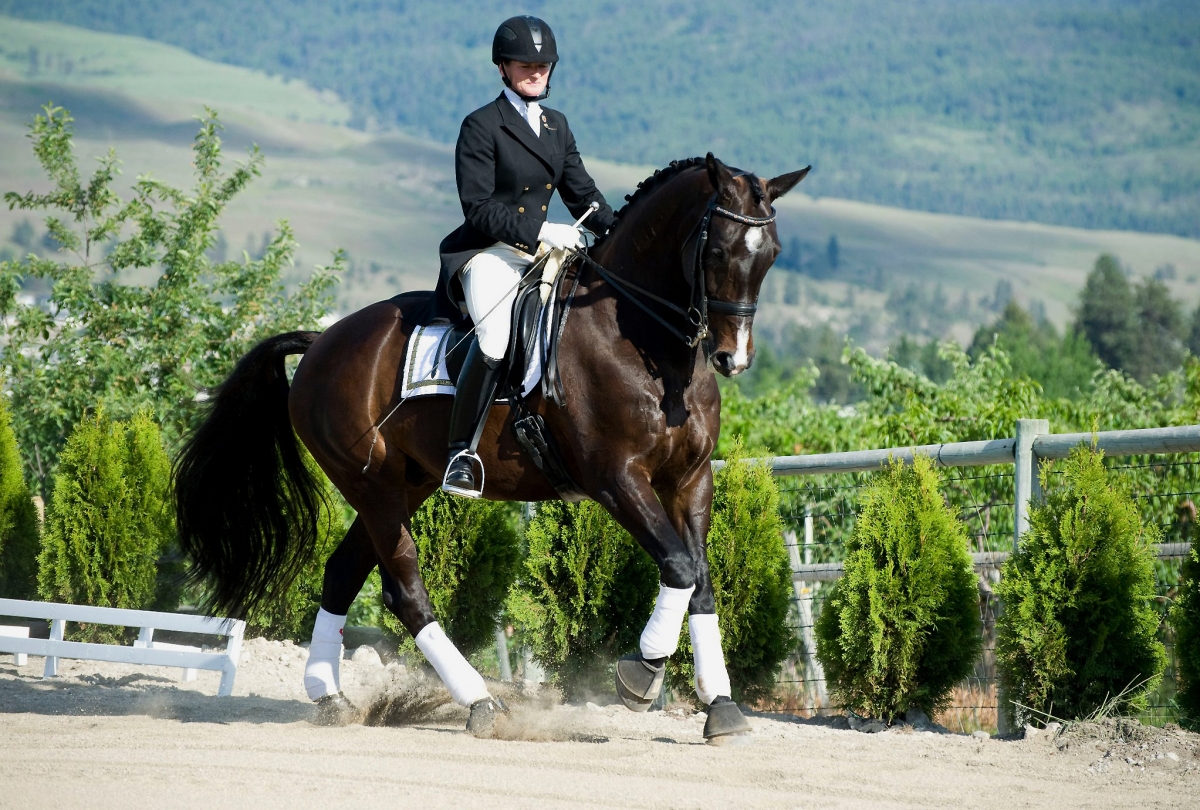
Travolta, bred by John and Jacqueline Van Den Bosch, is owned and ridden by Joni Lynn Peters of BC. The pair has officially declared for the 2012 London Olympics in dressage. Photo: Erin Rispin
Travolta, a Canadian Warmblood gelding by Ferro out of a Landwind II mare, is well on his way to qualifying for the Canadian dressage team for the 2012 Olympics in London with owner Joni Lynn Peters of Armstrong, BC. “He’s a very light yet a powerful, athletic type,” says Peters of her horse. “He’s a nice combination of lightness and strength, and he has a real natural affinity for the collected movements, the piaffe and the passage.”
Travolta was bred by John and Jacqueline van den Bosch of Bosch Farms in Red Deer, Alberta, and was consigned to the 2003 Fall Classic Breeders’ Sale as a three-year-old. Before even travelling to the auction, Peters had researched the pedigrees of the sales horses. “He was well bred so I already thought he might possibly be a fantastic dressage prospect...once I’d laid eyes on him there was no turning back.”
Since his first year of serious competition in 2005, when he was undefeated in BC at First Level, Travolta has bounded through the dressage levels. He was the Western Regional Grand Prix Champion as well as the Pacific Regional Grand Prix Champion for 2011.
Peters describes working with Travolta as “fantastic. I find him honest and smart, kind and incredibly talented...he’s always had so much potential.”
Now, having officially declared for the 2012 Olympics with Travolta, Peters says, “I’m just continuing to live my dream of riding this horse.”
Lindor’s Finest, by Eastern Ruler out of a Farn mare, is another horse whose rider, Canadian Ute Busse, has declared for the 2012 Olympics. Bred by Dorita Kozak of Ontario, the 1997 gelding is owned by Busse and Sylvia Carlton, both of Ontario. Currently Lindor’s Finest and Busse are competing at CDI-W and CDI3***.

Riding her Canadian Warmblood gelding, Buenos Aires (by Bajazzo out of an Arkansas mare), Sandra Donnelly of Alberta was the highest ranked Canadian rider in eventing at the 2008 Beijing Olympic Games. Photo: Shannon Brinkman Photography
In addition to their dressage prowess, Warmbloods in general are also lauded for their excellent jumping ability, and the Canadian Warmblood is no exception. At the 2008 Olympic Games in Beijing, Sandra Donnelly was the highest placed Canadian rider in eventing, riding her homebred Canadian Warmblood gelding, Buenos Aires.
“Buenos Aires was the first horse we bred,” says Donnelly of the 1997 gelding, who is by the Oldenburg stallion, Bajazzo, out of an Arkansas mare. “I could never afford to go to Europe to buy a nice horse, so I bred my own. He’s an amazing jumping horse, an amazing cross-country horse. In the barn he just loves to cuddle and is so sucky. I just like to be able to go out every day and enjoy riding him...and being around him all the time.”
Donnelly hails from just west of Calgary, Alberta, where she trains and runs a breeding program out of Alborak Stable. “I’m definitely breeding with eventing in mind. But eventers have to be quality jumpers so that’s what I look for, plus the movement for eventing, and, of course, a good mind.”
Donnelly commented that, as a Canadian, she likes that the CWHBA is a Canadian registry of a made-in-Canada breed. “For a young breeding federation, I think it’s doing really well. I just really like the Warmblood horses in general, and being able to register them in Canada is a service we just can’t do without.”
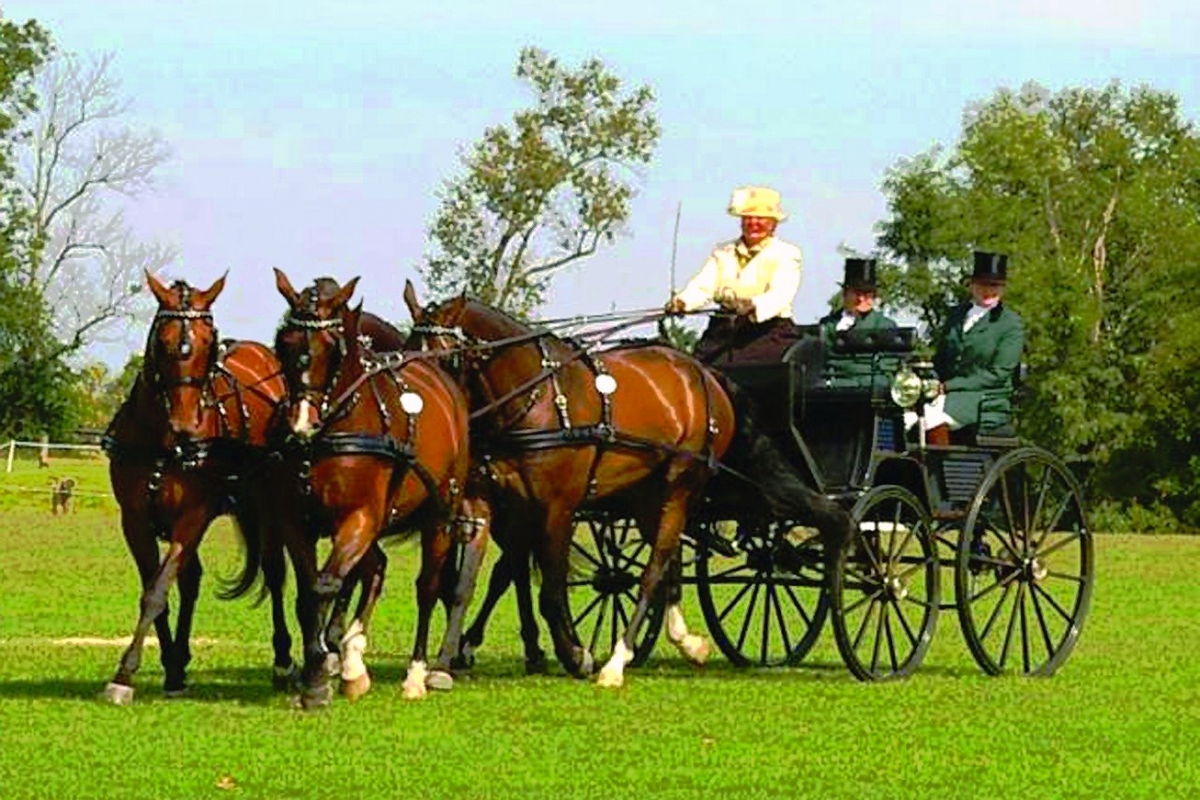
Vitanna (right front), by Kadans out of a Reve Du mare, competed in the Four-In-Hand Driving at the 2012 World Equestrian Games in Lexington, Kentucky. Vitanna, shown here driven by Deb Laderoute, is bred by Valerie Wilson and owned by Fred Mannix. Photo: Lorraine Hill
Another Canadian Warmblood international competitor is VDL Ulano, an Indoctro/Nimmerdor gelding who was bred by Hogendoorn Sport Horses in Ontario. Now competing as just ‘Ulano,’ the 2001 Grand Prix jumper was ridden by Canadian Karen Cudmore before being sold to Melisa International and moving to Turkey. Now Ulano is ridden by Burak Azak and is competing at the CSI3*** level.
Although they typically excel in the Olympic disciplines, the Canadian Warmblood is also competitive in other equestrian events.
Vitanna, a 2002 mare by Kadans out of a Reve Du mare, was a member of the four-in-hand driving team at the 2010 World Equestrian Games (WEG), proving the great versatility of the Warmblood.
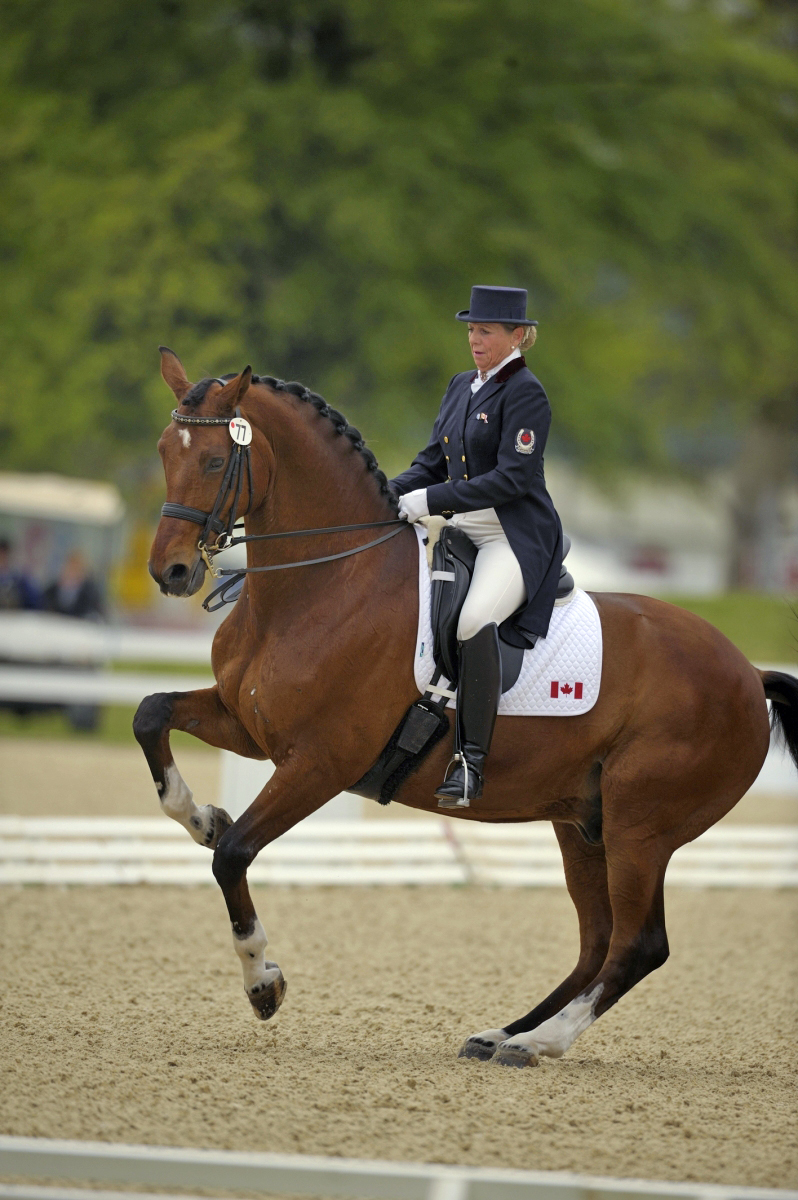
Canadian Warmblood gelding Pikardi, by Pointmaker out of a Diamont mare, and Canadian dressage rider Bonny Bonnello are shown at the 2010 Kentucky Cup Dressage Test Event, and later competed at the 2010 World Equestrian Games. Pikardi, bred by Northern Sport Horses in Manitoba, has since been sold to Chelsea Balcaen. Photo: Clix Photography
Looking to the Future
As riders like Peters and Donnelly can attest, athleticism, temperament, and rideability are the hallmarks of the Canadian Warmblood. However, the modern Warmblood must not only have the movement and athleticism to appeal to professionals, but also the temperament and disposition to suit amateurs.
“[Breeders] are putting a greater emphasis on rideability and handle-ability,” says Coote. “We still have to put emphasis on quality performance but look for good temperament...[amateurs] still want to get a good horse, they want to progress, they want to ride well, but they also want a safer ride.”
Gould offers advice to Warmblood breeders who are hoping to reach the amateur market without compromising on the quality of their offspring. “Aim for highest quality, but don’t forget disposition and rideability.”
Although the origin of Warmblood breeding lies in Europe, there is no question that Canada will continue the tradition for many years to come. As Gould puts it, in addition to producing horses with the temperament for amateur riders, “Our goal is to get our elite riders mounted and winning on Canadian Warmblood horses...it’s starting to happen which is really exciting!”
For more information on the Canadian Warmblood horse, as well as detailed instructions on registration, inspection, licensing, performance testing, and stud book eligibility, please visit the CWHBA website at www.canadianwarmbloods.com.
Main article photo: Andrew Bailini; Courtesy of Ruth Armstrong - VDL Ulando H, a Corland/Ahorn stallion, was bred by Hogendoorn Sport Horses in Ontario. Owned by Ruth Armstrong, he is currently long listed for the national Eventing Team at the 2012 Olympics in London with rider Karl Slezak.
This article was originally published in the February 2012 issue of Canadian Horse Journal.



